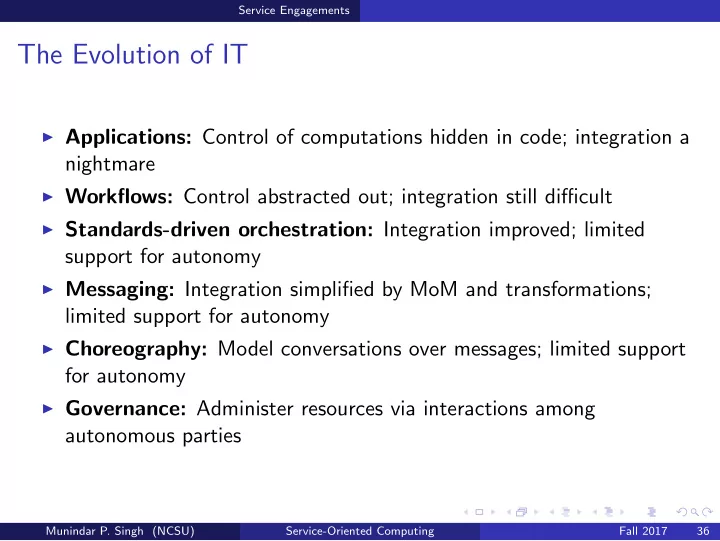

Service Engagements The Evolution of IT ◮ Applications: Control of computations hidden in code; integration a nightmare ◮ Workflows: Control abstracted out; integration still difficult ◮ Standards-driven orchestration: Integration improved; limited support for autonomy ◮ Messaging: Integration simplified by MoM and transformations; limited support for autonomy ◮ Choreography: Model conversations over messages; limited support for autonomy ◮ Governance: Administer resources via interactions among autonomous parties Munindar P. Singh (NCSU) Service-Oriented Computing Fall 2017 36
Service Engagements Technical Service ◮ Generally, an abstraction of a computational object ◮ Traditional, as in web or grid services ◮ Improved: Abstraction of a “capability” ◮ Well encapsulated, i.e., a black box ◮ Interface defined at the level of methods or messages Munindar P. Singh (NCSU) Service-Oriented Computing Fall 2017 37
Service Engagements Service Engagement An aggregation of business relationships ◮ Trillions of dollars worth of commerce conducted every year ◮ Characterized by ◮ Independence of business partners ◮ Coproduction ◮ Participation by all, though not at the same level ◮ Symmetric relationships: complementary capabilities and goals ◮ Produced on demand ◮ Complex contracts among the partners ◮ Participants are not black boxes Munindar P. Singh (NCSU) Service-Oriented Computing Fall 2017 38
Service Engagements Business Service Participant in a service engagement ◮ Characterized by transfer of (stakeholder) value, not bits ◮ Typically long-lived with on demand enactments ◮ Instantiated on the fly ◮ Unlike a product ◮ Though may be ◮ About a product ◮ Constructed using products Munindar P. Singh (NCSU) Service-Oriented Computing Fall 2017 39
Service Engagements Conceptual Elements of a Service Engagement ◮ Transactional: main purpose and enactment, specifying the stakeholder value exchanged ◮ Structural: partnerships and contracts ◮ Contextual: setting of the engagement Munindar P. Singh (NCSU) Service-Oriented Computing Fall 2017 40
Service Engagements Traditional Technical Approaches Quite unlike a real-life service engagement ◮ Take participants’ internal control and data flows (e.g., in BPEL, BPMN) as units of abstraction ◮ Mix private policies and public interactions ◮ Proprietary: may not be available for reuse ◮ Context-laden: even when available, cannot be readily reused ◮ Focus on low-level (e.g., WS-CDL) or data-level meanings (e.g., OWL) ◮ Ignore business-level significance of messages ◮ Ambiguous; not verifiable BPEL, BPMN, WS-CDL, OWL are well-known standards Munindar P. Singh (NCSU) Service-Oriented Computing Fall 2017 41
Service Engagements A Real-Life Service Engagement Operationally over-specified as interacting flows Munindar P. Singh (NCSU) Service-Oriented Computing Fall 2017 42
Service Engagements Message Sequence Diagrams Sequence Diagrams Well-known specification approach ◮ Originally used for object-oriented programming ◮ Our needs: closest to message sequence charts ◮ An intuitive way to express interactions ◮ Expresses global view consolidating local perspectives ◮ Excellent for describing possible interaction instances ◮ But beware the pitfalls . . . ◮ Support (potential) validation checks ◮ Formalizing semantics is not obvious: multiple approaches ◮ Standardized in UML 2.0 as Sequence Diagrams ◮ Caveat: Arrowheads and other details of these notes don’t necessarily match UML Munindar P. Singh (NCSU) Service-Oriented Computing Fall 2017 43
Service Engagements Message Sequence Diagrams Method Invocation in Object-Oriented Programming Only one thread of control; objects exchange messages p:Portfolio c:Customer a:Account getTotal() getBalance() balance total Munindar P. Singh (NCSU) Service-Oriented Computing Fall 2017 44
Service Engagements Message Sequence Diagrams Message Emission and Reception Independent threads of control; autonomous parties exchange messages, asynchronously sending and receiving c:Customer m:Merchant Request for Quote Munindar P. Singh (NCSU) Service-Oriented Computing Fall 2017 45
Recommend
More recommend